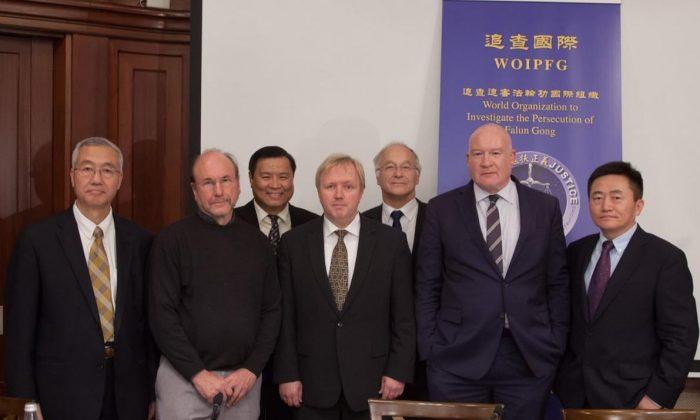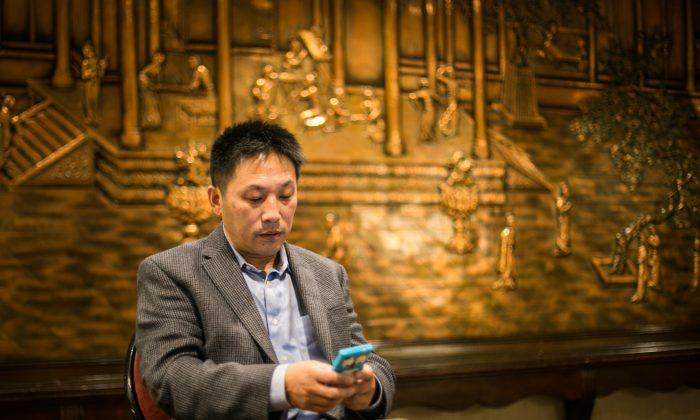The bulk of the Chens’ employment comes from calligraphers and painters of Chinese calligraphy, who require scrolls. Most scrolls are straight up and down, a loop at each end for the wood to slip into, and some ribbon for hanging; there are other scrolls which are more advanced—like those that open sideways and have treasure maps on them, as seen in martial arts movies—but the mainstay are fairly simple. The Chens can also do Western-style frames, and dozens of other variations.
Chen the elder got into the business when he was still in his teens. Back then, framers were all on the street level, their studios visible from the road. Young Chen would simply stand out the front of their shops and observe. As time went by, he started to do his own work. Between then and now 60 years have passed, and at some point during that time Chen himself became a scroll-making master.
A Timeless Process
The basic process of making scrolls hasn’t changed for thousands of years: The artwork is flattened with a kind of mixture, smoothed out, given a backing, left to dry, and the silk scroll attached.
First the work is laid flat on the table and sprayed with water, then hit with a layer of Chinese glue—the Eastern version of flour and water (they use rice and water). This step is a little tricky, because when applying the glue, the work has to be completely flush against the table. No air pockets are allowed. This requires using one hand to gently pull the work taut on its dry end, while spreading the lathered brush from the inside out, over both sides, until the whole work is flat on the table.
Depending on the kind of paper they deal with, the Chens also have to take different approaches. Thinner paper is much easier to tear, and needs to be given a harder backing, or even several layers of backing.
The backing is usually thicker than the original paper. It gets laid directly over the original when it is sticky with glue, but is somewhat larger in length and width. This few-inch margin is crucial—and it also needs to get pasted with a layer of glue.
Once the edges of the larger backing piece are sticky, the pair is lifted and stuck directly onto one of the vertical boards. It can stick to the board because of the magic margin of overlapping backing paper that was glued. There it is left to dry for a few hours.
After drying, the piece is cut from the board with another fruit knife, this one deliberately blunted to look like a spatula. What is being cut here is the backing piece. At this point, if the glue had stuck the backing piece to the work, the spatula-knife would rip through them both.
The final step after cutting the piece from the drying board is to attach the silken scroll. The work gets laid flat on the bench, the now-jagged edges cut clean with another time-worn custom-made blade, and then thin, patterned strips applied along each side.
These can only be seen when looking carefully, mostly they are a whitish color, the same as that of the paper. Only half of their one-centimeter length is applied to the work with a special glue, the other half is for joining the scroll material to the work. This material is a half paper, half hard silk, and comes in hundreds of patterns. The top and bottom are looped, and the wooden rods inserted in either end.
A Family Business
The Chens’ high-tide was sometime during the 80s and 90s, when a flood of Japanese business came into Taiwan. Materials and manpower were cheaper in Taiwan, so the Japanese would organize to contract businesses like the Chens’, and get the finished products shipped back. The Japanese always ordered the choicest materials, Chen Jr. explained, showing some example gold plated edge-rings, and noting that some customers would also order jade, or even diamond ones.
The Chens are proud of their business, and conduct. Their prices are quite reasonable too.
Once, a Canadian man who had previously been overcharged asked them to do some work. When it came to paying, he pulled out the same amount of money he’d paid previously—at least four times the actual price—thinking that was the standard. The Chen’s didn’t accept it though, and stuck with their regular prices. They also have a strong understanding of the importance of what they’re doing.
“You’ve got to do something with the pieces, right?” Chen Jr. said. “If you don’t have a nice frame or scroll, you can’t just put paper up on the wall, just like that.”
The Chens’ framings are all over the world—across Asia, in a handful of European countries, and there is even one, they said, in the White House.












Friends Read Free